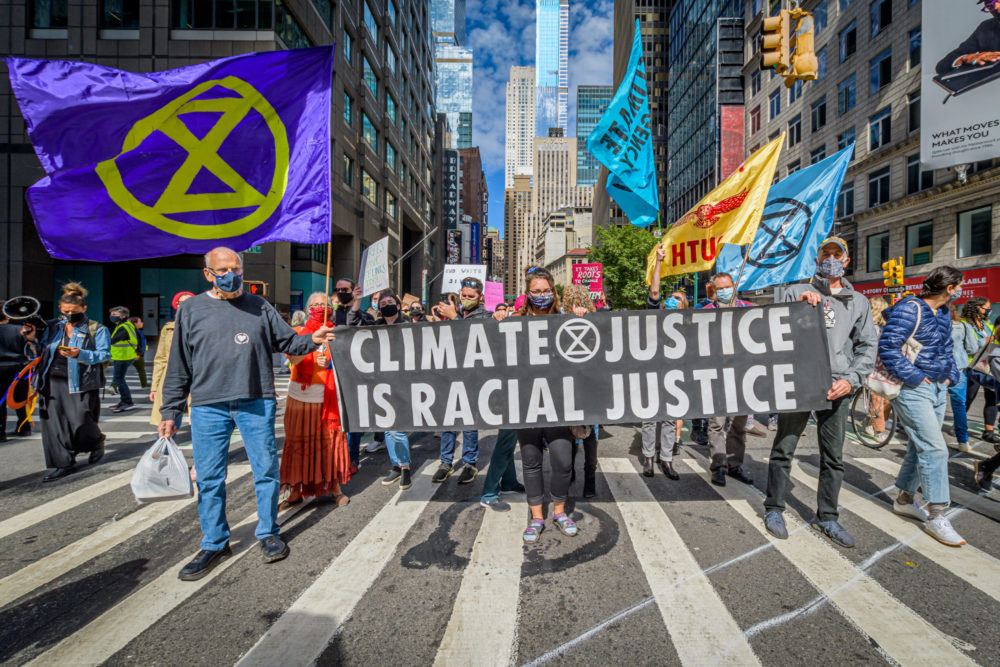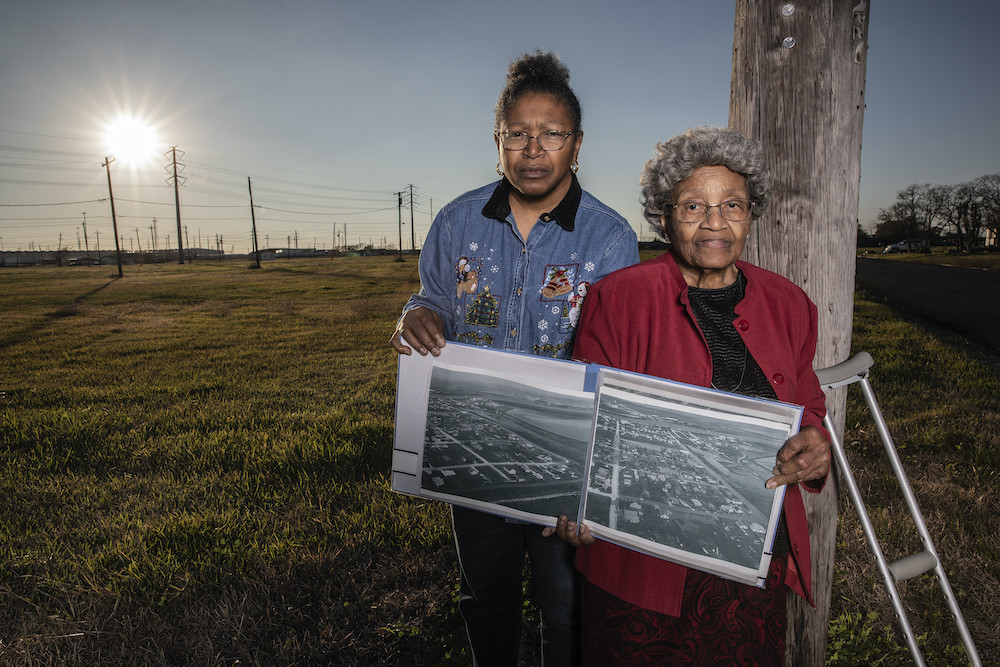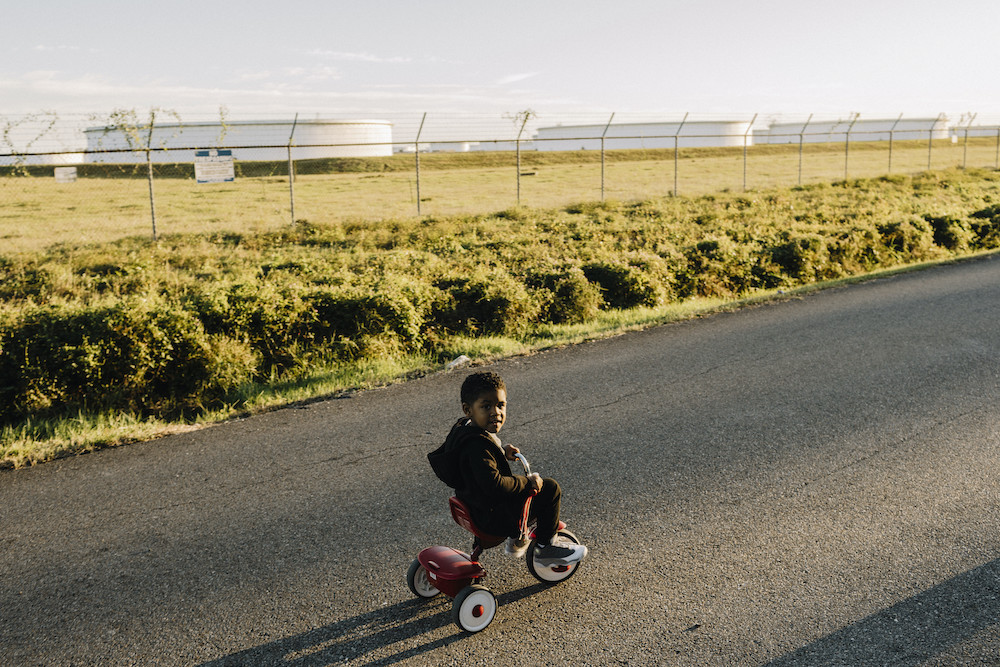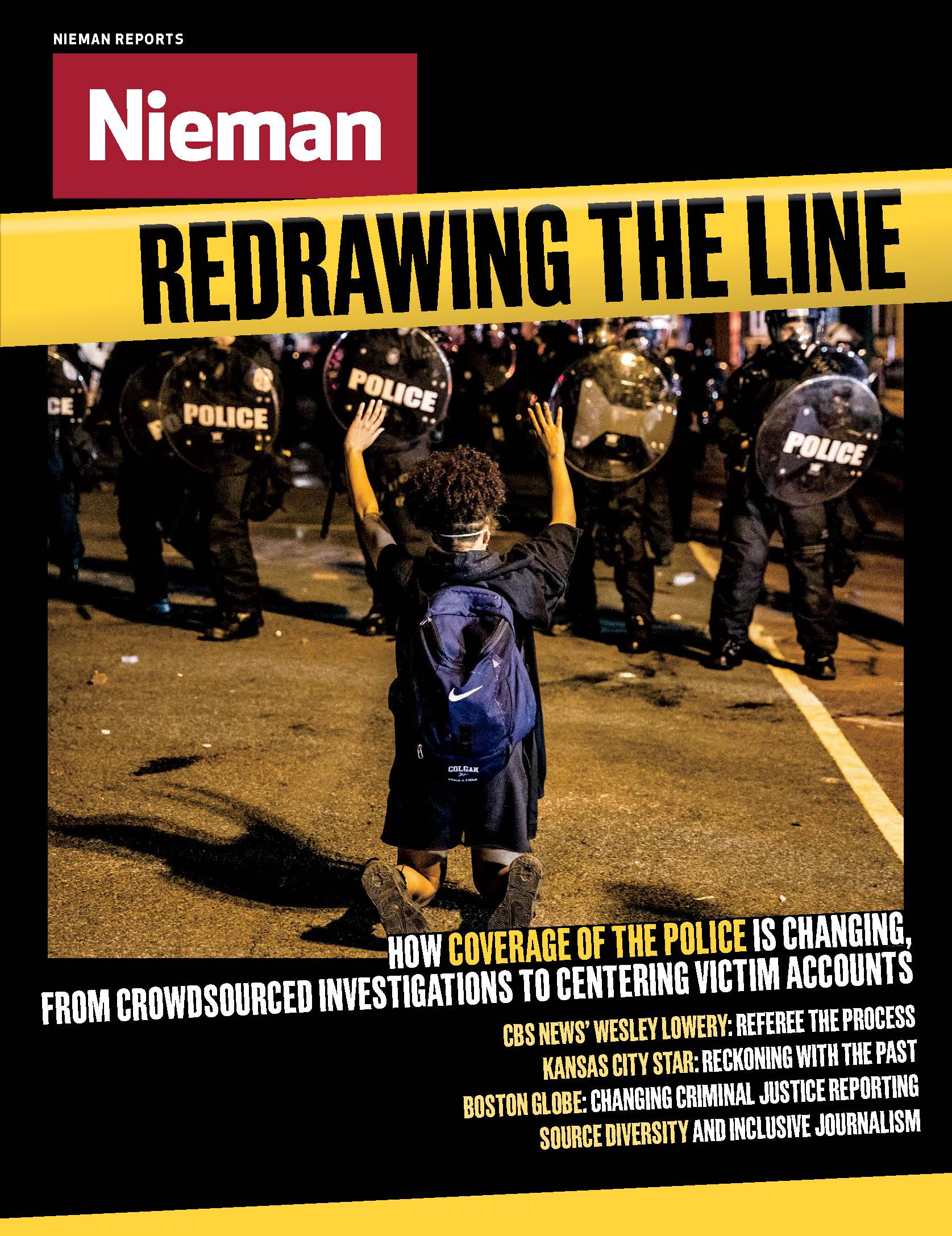
A coalition of climate, Indigenous, and racial justice groups gathered at Columbus Circle to kick off Climate Week with the Climate Justice Through Racial Justice march in New York City in September 2020
“I started asking myself, is there a potential story here?” Cabrera says. “When we think about the environment that these young boys grew up in and the challenges they face, a lot of it revolves around the built environment and also environments that have been brought on by heavy police presence in neighborhoods that are high poverty and have other types of challenges.”
Environmental justice reporting demonstrates that the issue of environmental racism impinges on every story
The question led Cabrera on a long reporting journey, where she discovered a serious environmental issue baked into the urban fabric of the neighborhoods in which the boys grew up: lead exposure.
A slew of studies have found that lead exposure, even at low levels, affects children’s cognitive abilities. Cabrera reached out to Howard Mielke, a lead expert at Tulane University, who has pioneered studies on lead exposure for decades, to walk her through his research. She also got in touch with Alison Young, who had just published a series on legacy lead contamination in former lead smelters across the country as an investigative reporter at USA Today.
After more research and reporting, Cabrera decided she wanted to take soil samples around the California neighborhoods where the undocumented minors grew up. With the training and assistance of Massachusetts-based science company Thermo Fisher Scientific, Cabrera was able to test more than 1,000 soil samples from the fall of 2015 to May of 2016, followed by more soil test analysis and reporting. In 2017, she went on to work as an investigative reporter at progressive news site ThinkProgress, where she published a five-part investigative series on the hidden toxic legacy of childhood lead exposure across the country.
The issues of environmental injustice and environmental racism remain largely absent in the daily news cycle. Environmental justice reporting — journalism that holds polluting industries to account and reports on vulnerable communities impacted by climate or environmental disasters and policies — is not just about the wildfires blanketing vast swaths of the American West or the record-breaking number of hurricanes inundating the Gulf region. It’s also about how these climate catastrophes add to the underlying environmental health hazards, such as rampant industrial pollution or military contamination, that are often intentionally integrated in marginalized communities.
Cabrera, now a senior reporter at Grist, is continuing her lead crisis series, mapping out the historical legacies of racist city planning policies that may have contributed to high sources of lead in these neighborhoods. These systemic disparities, according to Robert Bullard, professor of urban planning and environmental policy at Texas Southern University and a leading thinker on environmental justice, can be traced back to racist segregation policies such as redlining, the government-sanctioned effort to segregate communities of color by denying them housing loans and insurance.
Redlining has a history of depriving communities of neighborhood investment, labeling them “hazardous” mostly due to racial covenants and intentional lack of resources that further led to economic downturns, aging infrastructure, and environmental harms like high levels of lead in the soil. A 2019 study in the journal Climate, in fact, found that redlining is actually a major predictor of which neighborhoods suffer the most from extreme heat. White, wealthier neighborhoods tend to have more community investment, such as green spaces that cool the area, while poor and formerly redlined neighborhoods of color are slotted next to freeways and industrial areas.
“When you look at all the maps in the last 40 years — the Covid-19 map, maps of redlining, the map of extreme heat, map of food deserts, and so on — it’s the same map of disparities,” Bullard says. “That’s not a coincidence.”
After being long overlooked, environmental justice reporting is becoming more mainstream, prompted in part by the pandemic, the renewed calls for racial justice in the wake of the police killing of George Floyd, and the increasingly alarming effects of the climate crisis. Environmental justice reporting demonstrates that the issue of environmental racism impinges on every story — whether it’s race, housing, economics, healthcare, or immigration.
One of the first things environmental justice reporter Nina Lakhani did at The Guardian was to define environmental justice based on her early conversations with activists, scientists, and community members: “It is about who gets access and who doesn’t get access to clean air, to green areas, to healthy food, and to clean, safe, and affordable water,” she says. “As a starting point, that’s the definition I got from talking to veterans of environmental justice, mainly Black, Native, and brown activists, academics, lawyers, all sorts of folks who for many years have been talking about environmental racism, environmental inequality, and how communities of color, Native American communities in poor areas, are used as sacrifice, so they can be collateral damage.”
In 2020, with newsrooms pivoting to extensive coverage of the Covid-19 pandemic, which has now killed more than 400,000 Americans and has disproportionately impacted people of color, many outlets missed an opportunity to connect air pollution to severe Covid-19 outcomes. A Harvard study released in April, followed by an analysis by researchers from ProPublica and the State University of New York (SUNY) published in September, both found a close correlation between high levels of hazardous air pollutants and high Covid-19 mortality rates — which perhaps isn’t surprising given scientific research has long supported the connection between certain health conditions, including asthma and even cancer, and exposure to air pollution.

Susan Johnson and her mother Lila Lloyd, pictured in 2019 on a plot of land that their family owns in the East End neighborhood of Freeport, Texas, hold aerial photos of the East End from the mid-20th century. Amal Ahmed’s Texas Observer story details how the East End’s residential area has disappeared over the years as the city works to expand industrial areas and port shipping lanes
An analysis by nonprofit Media Matters for America found that throughout a four-week period from the end of March to the end of April 2020, only 7% of the 239 broadcast and cable TV news segments that covered the disproportionate Covid-19 death rates among people of color made the link to air pollution and other environmental hazards. In 2019, a report by The Solutions Project, an organization focused on climate solutions, found that while communities of color are disproportionately saddled with dirty emissions from the fossil fuel industry, only 2% of the 2,300 articles analyzed on renewable energy referenced communities of color, down from 7% in 2018. That year, lawmakers in states like New York were moving to pass climate and environmental justice legislation that would prioritize disadvantaged communities when it comes to clean energy.
Even George Floyd’s final words “I can’t breathe” became part of the rallying cry for the environmental justice movement that resurrected the National Black Environmental Justice Network, which Bullard co-founded. For Black people living near industrial facilities, the plea adds a layer of meaning when it comes to the disproportionate pollution burden they face every day, which is often ignored.
So it came as a surprise when Kristen Welker, NBC correspondent and the moderator of the second presidential debate in October, asked Donald Trump an environmental justice question during the climate portion of the debate: “Some people of color are much more likely to live near oil refineries and chemical plants in Texas. There are families who worry the plants near them are making them sick. Your administration has rolled back regulations on these kinds of facilities. Why should these families give you another four years in office?”
A spate of reports and studies have indeed shown the severe environmental and health impacts of living in close proximity to oil refineries and petrochemical plants. These plants spew out tons of hazardous greenhouse gas emissions and fine particulate matter that can easily travel into people’s lungs, causing health conditions such as cancer and asthma. Still, during Trump’s presidency, his administration rolled back more than 100 environmental rules allowing industries to pollute further.
When it comes to connecting systemic inequities to environmental harms, many outlets have been models for covering environmental justice.
The fossil fuel industry has a history of buying out communities from their land to build mammoth petrochemical facilities and oil and gas pipelines. This is evident in oil and gas-friendly states such as Texas and Louisiana, where predominantly Black neighborhoods are tormented by the dirty air released by refineries. In southeast Louisiana, the 85-mile stretch of the Mississippi River that connects New Orleans and Baton Rouge is dubbed “cancer alley,” since seven out of 10 U.S. census tracts with the country’s highest cancer risks are found in this corridor, housing more than 150 plants and refineries. The area has become a major environmental justice issue since Black communities tend to live the closest to these facilities, thus suffering the most severe health conditions.
In Texas, energy companies — mostly fossil fuels — drive the economy. Amal Ahmed, now a reporter at The Texas Observer, published a story titled “How to Erase a Neighborhood” in Texas Monthly in April 2020, about the dwindling neighborhood of East End in Freeport, Texas, a petrochemical town south of Houston. Houses, churches, and residents have slowly vanished over the years due to eminent domain and the city’s plans to deepen the port’s shipping channels and grow its industrial presence.
Meanwhile, pollution has worsened in many areas. In states like Texas and Louisiana, the oil and gas industry holds a huge amount of power not just in communities but also with government officials, which makes reporting on fossil fuel and environmental accountability especially challenging. In recent years, the fossil fuel industry has been trying to paint itself as environmentally friendly and sustainable by hiring public relations teams to protect brand identity and boost public trust. Activists call this “greenwashing,” if companies provide false or misleading information claiming that their business is sustainable and eco-friendly.
When it comes to connecting systemic inequities to environmental harms, many outlets have been models for covering environmental justice
The visceral description of the neighborhood of East End, which Ahmed visited, played a vital role in her reporting, witnessing firsthand the ramifications of industry build-up, such as empty lots and abandoned homes. “It’s a story that’s very much about the setting and the connections that people have to the place,” Ahmed says. “So I really wanted to get out there and talk to people in the place that they’re fighting for.”
Some environmental justice stories rely on pending lawsuits filed by environmental groups or community advocates against industries. Just as business journalists go through Securities and Exchange Commission (SEC) filings, environmental justice reporters go through lawsuits by major environmental law firms. When Ahmed pressed East End port officials with questions regarding a pending lawsuit she discovered, she was first met with zero to “no comment” responses.
In situations like this, Ahmed says, it’s important to ask questions that fully capture the efforts and measures public officials and company executives took to analyze and assess potential environmental impacts in nearby communities — if any at all. “It’s more like approaching those interviews with respect and understanding where they’re coming from, but then ultimately figuring out how it fits with everything else you heard and found in your reporting,” she says.
At The Guardian, before Lakhani was hired as an environmental justice reporter, she had been covering Mexico and Central America for almost seven years. One of the key issues she’s been interested in is the battle for natural resources and the dangers Indigenous environmental defenders face across Latin America. “So many conflicts, such as forced migration and the refugee crisis, have been fueled by the battle for natural resources, particularly land and water,” Lakhani says.
Water was recognized as a national crisis in America in the wake of the contamination in Flint, Michigan, followed by Newark, New Jersey, where low-income communities of color were the most impacted. As Lakhani pored over academic research and studies about who has access to clean and safe water in America, she noticed the problem is also about who can afford water as a commodity. She came across several reports that found a growing number of Americans were not only unable to afford clean water, but that a number of measures, some of them seemingly punitive — such as water shutoffs and moratoriums, in addition to aging infrastructure, contamination, and soaring prices by public utilities — all were huge factors in the lack of accessibility.
“That was when I sort of came up with this idea to really try and get the first national snapshot of the price of water and water affordability, which are obviously connected, but not exactly the same thing,” says Lakhani, who has published a series of stories on America’s water crisis in The Guardian.
It was an ambitious investigative project, and Lakhani and the editor agreed she couldn’t do it alone. They decided, for a small amount of money, to commission Roger Colton, an economist and lawyer who specializes in the affordability of utilities, to analyze water affordability in 12 demographically diverse cities, including Philadelphia, Cleveland, Detroit, and New Orleans.
Colton’s comprehensive data analysis — which looked at each year between 2010 and 2018, as well as forecasts for 2030 — became the backbone of her investigation. They found water bills rising across the country and millions of households, particularly those of low-income residents of color, struggling to afford such expenses. Meanwhile, federal aid to public water utilities has decreased, posing major environmental and public health risks due to lack of maintenance in water infrastructure.

A young boy rides his tricycle on Burton Lane in St. James, Louisiana, in 2019. The dead-end residential road is surrounded on three sides by heavy industry in an area known as “cancer alley”
When the first part of the series was published, traffic soared: “A lot of my life is spent doing things that are really important, yet don’t necessarily get well read, but this went crazy,” Lakhani says of the first piece.
As with climate reporting, science and data are crucial aspects in environmental justice reporting. What is the source of the pollution? What level of cancer-causing chemical benzene or carbon emissions does this oil refinery emit? How is fracking — or hydraulic fracturing — bad for the environment and public health? Answers to these questions are often found by going through academic and scientific research and interviewing experts.
Academic researchers and investigative reporters typically move at different speeds. But in Lakhani’s case, she saw an opportunity to join forces with an expert to make the story stronger. Lakhani says she and Colton were both motivated by the chance to elicit change in solving America’s water crisis: “Roger Colton was vital throughout; I couldn’t have done it without him. His findings informed my reporting and my reporting informed his investigation. I’ve never been in a position or had the resources to be able to hire anyone. If you can, obviously it enables your reporting to get to another level.”
Against the backdrop of the Covid-19 pandemic and a nationwide racial reckoning, environmental justice beats are gradually emerging in newsrooms. Still, with the recent elections and insurrection at the U.S. Capitol, it can be challenging to turn the spotlight to a hard-hitting environmental justice story. But many climate and environmental justice reporters have succeeded at finding connections across various beats and topics.
At the height of the Black Lives Matter protests during the summer of 2020, InsideClimate News reporter James Bruggers published a story connecting toxic pollutants to the high mortality rate and health impacts of Black people in Kentucky, where Breonna Taylor was fatally shot by Louisville police. Bruggers, a veteran local environmental justice reporter in Louisville, used the ongoing protests and renewed calls for racial justice as a news peg, then connected them to a recent study that found living in close proximity to Rubbertown, an industrial neighborhood in the city, had a major effect on life expectancy among low-income Black residents compared to their more affluent, often white counterparts.
“I kept up with the daily demonstrations around Breonna Taylor, which did not focus on Rubbertown, but provided a compelling reason for us to take a fresh look at them as an underlying factor calling for racial equity in Louisville,” Bruggers says.
While reporting on the story, he checked in with John Gilderbloom, a University of Louisville professor who has studied the city’s inequities around health and the environment. Gilderbloom happened to have some new research that was relevant to the story, so Bruggers ended up using it as a major supporting detail in his reporting. The research found that living in industrially polluted neighborhoods explains part of Louisville’s lifespan disparity.
Bruggers says it’s important to know history and data: “Check the data. In this case, it meant checking on chemical plant emissions reports going back to the 1990s, finding studies in scientific journals, finding reports from the local health department, and just having a data state of mind, so that you can be sure your story is grounded in facts.”
Environmental justice reporting is all about community stories, which is why covering the issue can strike some as a type of activism
In the story, Bruggers dug out and studied a local health department report from 2017 when city officials assessed various socio-economic factors, including the environment, and found startling disparities of as much as 10 to 12 years in life expectancy between poor and wealthy neighborhoods, particularly poor Black and white communities in industrial areas.
“Know that the world did not begin the day you start reporting a story,” Bruggers says. “History matters, and in this case, a lot of that history was in my head. But I did go through [the Louisville Courier-Journal’s] story archives dating back decades to give the story the historic context it needed.”
Environmental justice reporting is all about community stories, which is why covering the issue can strike some as a type of activism. When Lakhani, The Guardian reporter who put out the series on American water crisis, thinks about her approach to covering environmental justice issues, she says she first identifies the environmental problem, then proceeds to report and investigate the problem with the hope that her findings will elicit systemic changes: “I’m definitely not an activist, I’m a journalist, but I would consider myself a campaigning journalist. I get behind issues and I report on them … I really try to make the data into a usable type of journalism.”
The Trump administration — which systematically attacked journalism and facts — was a particularly crucial time for environmental justice reporting. The administration not only undermined climate science, but also aligned itself with the oil industry and overhauled significant environmental regulations and policies, such as the bedrock 51-year-old National Environmental Policy Act that most activists rely on to protest polluting infrastructure. Most recently, the administration sold off drilling rights in parts of the Arctic National Wildlife Refuge in Alaska, which Indigenous people say is sacred land.
And in the wake of the nationwide protests for racial justice, newsrooms are also having their own racial reckoning. Major newsrooms like The Washington Post and USA Today have been hiring for new reporting roles that focus on racial inequities, including environmental justice. With environmental justice making its way to the forefront of climate and racial coverage, journalists like Cabrera believe that change is on the horizon.
“We know enough generally about the harmful, damaging, and ill effects of the pollution that comes from either a refinery or lead contamination,” Cabrera says. “But for many years when communities raised these concerns, they were just simply ignored, because we didn’t have any proof. And so what’s so gratifying to work on this beat now, when people are asking, how can we have a fair and equitable system, is that people’s eyes are wide open and [they] are asking questions on how can we address these issues systemically.”


